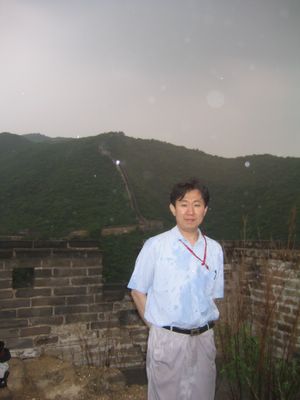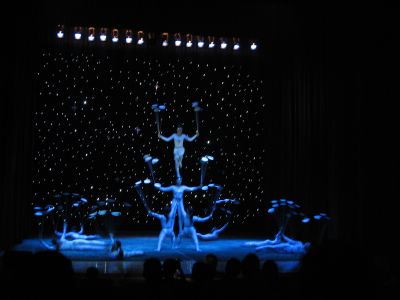In Shanghai there is a kind of wild-west atmosphere as the city grows wildly, sprouting modern skyscrapers like grass. In contrast, Beijing is a little more subdued. In Beijing there is no towering skyline, but the Ming and Qing dynasty temples and palaces are equally impressive reminders of kingdoms past, while Tiananmen square serves as a symbol of the present.
Shortly after our arrival in Beijing, we took a taxi to the nearby Temple of Heaven park. First constructed in 1420, the Temple of Heaven is a complex of buildings where Ming and Qing Emperors made sacrifices and prayed for good harvests.
After purchasing our tickets (30RMB) we headed through the gate. Once inside, it seemed like we were transported out of Beijing - lots of tall juniper trees blocked the sights and sounds of the city and provided a nice piney fragrance.

Temple of Heaven Park - North Gate

Hall of Prayer for Good Harvests
The Hall of Annual Prayer is the largest and most recognizable building in the complex.

Hall of Annual Prayer

Hall of Annual Prayer

Hall of Annual Prayer - Detail

Temple of Heaven - rock sculptures

Temple of Heaven

Temple of Heaven

The middle of a forest is an interesting place for a no smoking sign.
On the evening of the first day we met our old Houston friend Olen (now a Beijing 'local') and his wife Cathy for dinner. They took us to a local restaurant and took charge of the ordering, which was really helpful because the English version of the menu was poorly translated and a bit cryptic, offering items such as 'slippery beef.' Due to their experience we ended up with more appetizing dishes, including sauteed green beans, fried pork ribs, stir fried beef with peppers, baked eggplant, and fried rice. Mmmm!
The next day we walked from our hotel to Tiananmen square, the center of Beijing and the site of many notable political events. It was here Mao proclaimed the formation of the PRC in 1949, and the site of the 1989 protests that culminated in military intervention on June 4th of that year. Today the broad expanse of pavement is guarded by both uniformed and plainclothes officers that will quickly act to dissolve any person group that tries to protest. A couple days after our visit to the square, the 17th anniversary of the June 4th crackdown, two people who tried to protest were detained. Luckily when we visited we were only accosted by people selling postcards and a father, presumably a Chinese tourist from outside Beijing, who wanted to take our photo with his son.

Tiananmen Square

Statue outside Mao's Mausoleum

Tiananmen Gate

Tiananmen Gate

Museum of Chinese History

A line of tourists queue to see Mao under glass
Just north of Tiananmen square is the Forbidden city, the palacial home of 24 Ming and Qing Emperors. It was the center of China's political power from the 15th century to the early 20th century. We intended to spend a half day at he Forbidden City, but because of the sheer size it took us almost the whole day just to walk through the main areas.

Meridian Gate
Bronze and stone lion sculptures are all over China and there was no shortage of them at the Forbidden city. Typically they are in pairs; the male lion holds a ball while the female lion holds a cub.

Lion outside the Supreme Harmony Gate
Everywhere we went in Beijing we saw scaffolding on historical buildings, as Beijing prepares for the onslaught of the 2008 Olympics. During our visit the Hall of Supreme Authority was completely covered with scaffolding and netting. They were kind enough to paint a picture of the building on the netting so we could get a feel for what it was supposed to look like.

Hall of Supreme Authority

A recently restored section of the Forbidden City

Nine Dragon Screen - enameled tile

Nine Dragon Screen - enameled tile

Lost in the Forbidden City
While the Forbidden City is famous for its wide courtyards, there are also many gardens where the Emperor and Empresses would retreat to relax and write poetry.

Pavilion in the Imperial Garden

Intertwined pines in the Imperial Garden

It was tempting to go climbing in the rock garden, but the sign said no.

Another Lion

Enameled tile wall

Imperial Garden

Forbidden City Doors

Forbidden City - roof detail

View through a door

High walls kept invaders at bay

Imperial city moat.
On day two we were too tired from walking to take our chances at a local restaurant, so we ate dinner at Pizza Hut. This turned out to be a cultural experience in itself. First, there was a line to get in... seemingly strange for a country where cheese is rarely eaten by locals. After we were seated we ordered a standard pepperoni pan pizza. While we waited we observed an interesting phenomenon at the salad bar. Evidently Pizza Hut salad bars in China are sold as a single-trip. Locals took their bowl and went to the salad bar and meticulously stacked slices of cucumber and pineapple around the outer rim of the bowls until the amount of 'salad' on top of the bowl far exceeded the amount below the rim. Several people spent 15 or 20 minutes on their creations, making sure to maximize the value in their salad bar trip. Many of the creations were surprisingly artistic, and pretty much all of them were enough to be shared by four people sitting together.

Ashamed to be in the queue for Pizza Hut
The next day we arranged to be taken to the great wall by Alvin Jiang, a Beijing local who was recommended by a traveler on the Virtual Tourist website. Getting to the wall was a bit of an adventure when Alvin showed up at our hotel in a car with an empty gas tank. We searched in vain for a gas station, thinking that we would soon run out and have to sit on the side of the road for rescue. Thank goodness we finally found some fuel and made it to the wall at Mutianyu.. a restored but not overcrowded section of the 6000+km wall.
The wall is situated mostly on mountainous ridgelines. From the base at Mutianyu, there are three ways to get up: 1) Hike 2) Ski Lift 3) Gondola Lift. We decided on option #3, as it was raining when we arrived at the wall. Alvin said this was the first time he had seen it rain at the wall.. 'lucky us', we thought. Undaunted, we put on our raincoats and grabbed a ticket for the Gondola.

In the Gondola
On the wall there are enclosed fortifications every few hundred meters, so when the rain began falling heavily we waited in a fortification. When the rain let up, we headed to the next fortification. While the rain was a bit of a nuisance, it was also a blessing because it drove away other tourists, and we were alone on a long section of the wall for several hours.

Great Wall Map

Mutianyu Great Wall

Getting a bit wet on the wall

Alvin

Mutianyu Great Wall

Mutianyu Great Wall
After walking for a while we reached the end of the restored section of the wall. Beyond, the wall was crumbling and overrun with trees and shrubs.

Unrestored section of the Great Wall

Mutianyu Great Wall

Mutianyu Great Wall

Fortification

Mutianyu Great Wall
On the next day we traveled to the Summer Palace, which was built mainly in the 18th and 19th centuries. Aptly named, the Summer Palace was where Emperors and Empresses retreated for the hot summer months.

Summer Palace
The Summer Palace is a popular destination for Chinese tourists, and it can get quite crowded, especially on the weekend.

Summer Palace crowds

Summer Palace

Summer Palace Gate
At the center of the Palace is Kunming lake, which was hand-dug by 100,000 laborers. A very popular activity is taking rowboats and paddle boats out for a cruise.

Kunming Lake

Summer Palace Gate
Empress Dowanger Cixi frequented the palace during her rule from 1861 to 1908. This car was given to her as a gift and supposedly was the first car in China.

Empresses' Car

Musicians

Summer Palace Theatre
No royal Chinese garden is complete without a plethora of interesting rocks. Some look like petrified wood, some are full of holes. Evidently this particular rock enticed a gentlemen to such an extent that he spent his entire fortune trying to get it to his garden. He failed and it somehow ended up at the summer palace instead.

Huge ornamental rock

Summer Palace Gate
This marble boat was built by the Empress Dowanger with money earmarked for the Chinese navy. Her frivolity with military funds contributed to the fall of the Forbidden City to allied forces during the Boxer Rebellion.

Marble Boat (Obviously does not float)
On Saturday night we met up with Olen and Cathy again and had a traditional Beijing Roast Duck dinner. Afterwards we went to an acrobatics performance.

Acrobat Show

Acrobat Show

1 comment:
Wessimo!
It’s great to read and see all the images from your travel adventures.
What wonderful opportunities you are having to see the world!!! Surely a blessing from the Lord.
Congratulations on your recent marriage. Good luck with that travel writing, I can't wait to see your first guide book!!!
hannah
Post a Comment